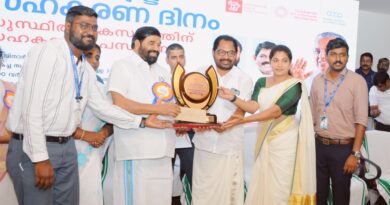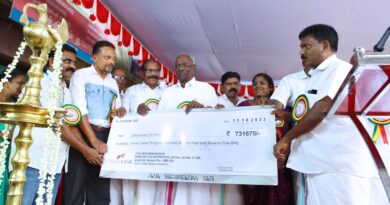100 ചോദ്യങ്ങള് ഉത്തരങ്ങള്
QUESTIONS
- England’s co-operative movement is considered as __________ movement.
- The main aim of labour colonies started by Robert Owen was __________.
- Robert Owen started labour colony in ________ in the year 1839-1845.
- ___________ was the first woman member of Rochdale Equitable Pioneer society who was admitted in March 1846.
- In the year _____, Rochdale pioneers entered into wholesale trade.
- “The north of England co-operative wholesale agency and depot” changed its name to ______ in the year 1867.
- Liability of the CWS members was __________.
- The Scottish Co-operative Wholesale society set up a factory to produce food items, clothing, furniture etc.. at _________.
- ‘Village Societies’ was the fundamental idea of ____________.
- In Denmark, first consumer store was started in the year _________.
- In the year 1973, _________ was officially regarded as the apex consumer organization in Denmark.
- First diary co-operative in Denmark was organized at ___________.
- A pricing policy in fixing the price of the produce by the Swedish Co-operative movement is called ___________.
- KF entered in the wholesale trade in the year _________.
- KF established an education centre in _________ in India in collaboration with ICA.
- Jean Jenny Ryffel started first consumer co-operative in _____________.
- __________ is known as the pioneer of labour co-operative societies.
- ___________ is the torch-bearers of the world in the field of producer’s co-operatives.
- One of the pioneers of kibbutz movement, who wrote a book about his experiences was _____________.
- Moshav ovdim is a ______________ settlement in Israel.
- In Israel, Moshav Olim were introduced in the year __________.
- Headquarters of Jewish National Fund (JNF) is at __________.
- __________ is the purchasing organization of the kibbutz movement in Israel.
- __________ is the largest and oldest labour organization in Israel.
- Royal commission of agriculture was constituted during the _____ stage of development of co-operative movement in India.
- The society is shall be deemed to have commenced working if it has held ____________ after its registration and admitted members.
- Ayurveda co-operative societies are __________ type of societies.
- Educational co-operatives have a ______ tier structure.
- The registrar may by his own motion will remove a member, when the member become ineligible to continue as such, as per rule ____ of KCS Rule.
- When the original of an identity card for which the duplicate was issued has been recovered, _____ shall be surrendered to the society for safe custody.
- The societies whose application for affiliation stand rejected shall have the right to appeal before ________.
- The government or the Registrar may nominate all or any of the members of the first committee of the society including the president or chairman, for a period of ___________.
- The lapse on the part of the chief executive on furnishing the statement and returns in stipulated time period will be considered as ________.
- The cost for inspecting the list of members as on the last day of each co-operative year by any member during office hours is ___________.
- For constituting representative general body, the number of member of society shall not be less than _________.
- The rank of officers to be posted for election duty may be fixed by SCEC in consultation with _______.
- On the day following the date fixed for the receipt of nomination paper, the ________ shall take up to the scrutiny of the nomination paper.
- Election and term of the member of committee is defined in rule ____ of KCS Rules.
- The meeting convened under rule ____ shall not be adjourned.
- Rule 44 of KCS Rule deals with disqualification of _____________.
- A paid employee of a society is disqualified to be in member of committee unless the society is a/an ___________.
- Section 50 of KCS Act deals with _______________.
- In eligible cases, the government may exempt societies considering its financial position from setting off _____________.
- Government may constitute a committee not more than ________ for the administration of the co-operative education fund.
- Member relief fund shall be remitted within ______ period from the date of receipt of audit certificate.
- No society shall dispose any immovable property acquired by the society without the prior sanction of _______ and _______.
- No credit society shall grant loan exceeding ________ period as per rule 56 of KCS Rule.
- Mode of investment of reserve fund is mentioned in Rule ___ of KCS Rules.
- ________ shall be indivisible and no member shall have any claim to a share in it.
- As per rule 63, ____% of the total demand and time liabilities at the close of business in any day shall be kept as fluid resources by societies.
- The Government of India set up Industrial Reconstruction Corporation of India (IRCI) in the year ______.
- Banking commission in the year 1972 under the chairmanship of _______ recommended setting up of Credit Intelligence Bureau as a statutory body.
- Controlling of UCB’s by the state government and RBI is generally known as ________.
- Banks have adopted the 90 days norms for classification of NPA from______________.
- Recommendation from the Kelkar committee in 1986 were incorporated as amendments to ___ act.
- The government of India initiated the process of amalgamation of RRB’s sponsored by the same bank within state as per the recommendation of ___________.
- EXIM bank amendment act 2011 provides for an increase in the authorized capital of EXIM bank from 2000 crores rupees to _________.
- Under ________ banking system, commercial banks meet the short term and long-term requirements of industries.
- ________ banking refers to banking in which banks undergo transactions directly with consumers rather than with corporations or other banks.
- The system of banking under which bank places its fund in risk-free assets with maturity period matching its liability maturity profile is called _________.
- Chairman of the committee on Capital Account Convertibility in the year 1948 is ___________.
- The first private bank in India to be setup in private sector was _________.
- The position of bank account is depicted in a small book called ________.
- Loans lend to the people on the basis of their perceived personal worth is called ________.
- ________ promissory note that do not carry a specific maturity date.
- _______ refers to the directives of the central bank to enforce the commercial banks to follow a particular policy.
- Multiple Indicator Approach in banking sector was adopted in the year _______.
- When money is borrowed or lent for more than a day and up to 14 days is called ________.
- Minimum amount of bid of treasury bill is __________.
- Participation certificates are strictly inter-bank instruments confined to the _________ banks.
- The minimum lock-in-period of certificate of Deposit (CD) is _________.
- ________ refers to the short-term unsecured promissory notes issued by corporate companies with a high credit rating.
- _______ refers to the market for the government and semi-government securities backed by the RBI.
- _______ are the financial institutions which undertake to secure a committed quantum of equity subscribed by the public, failing which they accept these shares are their own investment.
- It is mandatory that every NBFC should be registered with ______ to commence or carry on any business.
- Bills sent for collection is a __________.
- ________ are the assets that shown on the asset side of balance sheet even if they are not real assets.
- _____ is the increase in the net worth of the organization either from business activities or other activities.
- As per __________ principle, revenue is measured by the amount charged for goods sold or services rendered to the customers.
- Creditor’s equity is also known as __________.
- In the case of return of goods, __________ account is credited.
- ________ serve as a summary of what is contained in the ledger.
- Only _____ stock appears in the trial balance.
- In _______ accounting, importance is given to projection and estimates.
- _________ are statements which shows the financial position of a firm at different period of time.
- Financial statements can easily be __________ to present a better picture of its financial and profitability positions to the outsiders.
- ________ is the process of predetermining the cost of product or a service.
- Limitation of financial accounting is that it does not exercise any control over ________.
- _______ is the sum total of all direct cost.
- The total of all items of expenses incurred in the manufacturing of a product is called _________.
- Set apart profit not meant for any specific purpose is called _________.
- Purchase bonus is charge on the _____ profit of the societies.
- ______ is a privilege to use an invention for a number of years.
- Manufacturing account is the subdivision of _________.
- Payment postponed to a future date is called __________.
- Fixed assets sold on credit is recorded in _________.
- Cash sales are debited in ______.
- ________ expenditure will never be loss to the business.
- Another name of nominal ledger is _________.
- Legal expenses incurred in connection with purchase of fixed asset is treated as ________.
ANSWERS
- Consumer Movement
- Elimination of middlemen
- Queenwood
- Eliza Brierley
- 1855
- Co-operative Wholesale Society
- Limited Liability
- Shieldhall, Glasgow
- Raiffeisen
- 1886
- FDB
- Hjedding
- Active Price Policy
- 1904
- New Delhi
- Switzerland
- Italy
- France
- Yosef Baratz
- Worker’s Co-operative Settlement
- 1948
- Jerusalem
- Granot Central Co-operative
- Histadrut
- Third Stage/Unplanned Expansion Stage
- First General Body
- Processing Societies
- Two Tier Structure
- Rule 16(4)
- Original ID Card
- The Registrar
- Not Exceeding twelve months
- An Offence
- Free of Cost
- 1000 members
- Government
- Returning Officer
- Rule 39
- Rule 43A
- Membership of Committee
- Employees Co-operative Society
- Disposal of share capital and dividend
- Government Dues
- 5 members
- Two Months
- General body and Registrar
- 120 Months
- Rule 60
- Reserve Fund
- 20%
- April, 1971
- G. Saraiya
- Dual Control
- 31st March, 2004
- RRB Act
- Vyas Committee 2004
- 10000 crore rupees
- Mixed Banking
- Retail/Consumer/Personal Banking
- Narrow Bank
- S. Tarapore
- IndusInd Bank
- Passbook
- Clean Loans
- Demand Promissory Note
- Direct Action
- April, 1998
- Notice Money
- 25000
- Scheduled Commercial Banks
- No Period
- Commercial Papers
- Gilt-edged Market
- Underwriters
- RBI
- Contingent Liability
- Fictitious Assets
- Income
- Revenue Realization Principle
- Liability
- Return outward account
- Trial Balance
- Opening Stock
- Management Accounting
- Comparative Financial Statements
- Window Dressed
- Cost Estimation
- Material or Labour
- Prime cost
- Factory cost or Work Cost
- Reserves
- Gross Profit
- Patent
- Trading Account
- Credit transaction
- Journal Proper
- Cash book
- Capital Expenditure
- General Ledger
- Capital Expenditure




